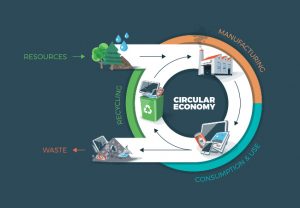The Circle of Hope?
Welcome back!
A few days ago, I discovered that the linear supply chain is changing into a circular supply chain. You might wonder what does the supply chain have to do with sustainability? The answer is: Everything. The circular supply chain is based on sustainability while the linear supply chain is not. Today, I will explain the differences between them and some companies that are integrating a circular supply chain that I call, the “circle of hope”.
Our system is based in a linear supply chain being “the steps it takes to ge t the product or services to the customer.” I consider this to be the biggest failure of human history. Why? because it stops when the consumer buys the product as companies do not think of the “after” purchase and do not take into consideration the waste of the products. Hence, assuming that resources as unlimited.
t the product or services to the customer.” I consider this to be the biggest failure of human history. Why? because it stops when the consumer buys the product as companies do not think of the “after” purchase and do not take into consideration the waste of the products. Hence, assuming that resources as unlimited.
The circular supply chain solves all the linear supply chain problems. It is defined as a transition from raw material  to manufacturing center to distribution center to consumer to trash process. This value chain solves the problem of limited natural resources by reusing wasted products. In short, the process never stops. As it is mentioned in the study The Global Networked Value Circle: A New Model for Best-in-Class Manufacturing, this model “optimizes everything from product design and the manufacturing of goods to sales and supply chain management.”
to manufacturing center to distribution center to consumer to trash process. This value chain solves the problem of limited natural resources by reusing wasted products. In short, the process never stops. As it is mentioned in the study The Global Networked Value Circle: A New Model for Best-in-Class Manufacturing, this model “optimizes everything from product design and the manufacturing of goods to sales and supply chain management.”
Many multinational companies such as P&G are applying this concept. Only 10 days ago the company announced the creation of the world’s first recyclable shampoo bottle. Taking into consideration that plastic contamination in the ocean is one of the biggest environmental problems this decision to eliminate manufactured waste by reusing the plastic in the ocean into their shampoo bottles is momentous.
It is a positive sign that P&G is implementing this model because this will create a ripple effect, motivating other companies to do the same. The lack of natural resources is a worldwide problem that every company should be concerned about. The question is, for how long will we be able to survive with this circular approach?
Thank you!
Maria
References:
The emergence of more circular economy products and companies are definitely becoming prevalent in our everyday lives. I’ve mentioned it in a number of my blog posts as well, but I’m a big fan of design, and although I am absolutely in support of the circular supply chain model, one of the biggest criticisms I have of the model is that it does not talk into consideration the design that goes into certain products. While products are being built with more sustainability in mind, the design of products creates inefficiencies in itself.
For example, in our kitchens, we might have Energy-Star efficient appliances (an electric kettle for example), but when people boil water for a cup of tea, they typically boil much more than they need, expending more energy from the grid, and thus creating an efficiency in the system. So, in a sense, we must be able to integrate more sustainable design into the circular process that companies are adopting, not simply just adopting the system as-is. Great post.